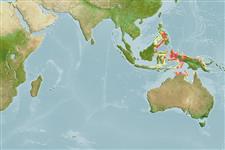Classification / Names
Common names | Synonyms | Catalog of Fishes (gen., sp.) | ITIS | CoL | WoRMS | Cloffa
Actinopterygii (ray-finned fishes) >
Perciformes (Perch-likes) >
Pseudochromidae (Dottybacks) > Pseudochrominae
Etymology: Manonichthys: Name is a combination of Greek manon which is a kind of sponge, and ichthys for fish, referring to the sponge-dwelling behaviour of the species under this genus.; jamali: Named for a hardworking crew member of M.V. CITRA PELANGI diving vessel, Jamal,.
Environment / Climate / Range
Ecology
Marine; pelagic-neritic; depth range 9 - 16 m (Ref. 74994). Tropical, preferred ?
Western Pacific: Indonesia.
Size / Weight / Age
Maturity: Lm ? range ? - ? cm
Max length : 10.0 cm TL male/unsexed; (Ref. 90102)
Short description
Morphology | Morphometrics
Dorsal
spines
(total): 3;
Dorsal
soft rays
(total): 28-29;
Anal
spines: 3;
Anal
soft rays: 15 - 16. This species is distinct from its congeners in having the following features: pectoral fins hyaline; at least some ctenoid cheek and opercular scales; caudal-fin is rounded to truncate in young fish to strongly emarginate or lunate in adults; predorsal scales 17-22, extending anteriorly to point ranging from slightly posterior to slightly anterior to PIO pores; presence of a prominent dark bar across anterior caudal peduncle and adjacent posterior body extending onto basal 1/2 of posterior dorsal and anal fin rays (Ref. 74994).
Inhabits frequently dense thickets of staghorn Acropora corals, encrusting layers of Galaxea corals, or rocky debris at depths of about 9-16 m. Either encountered solitarily or in loose groups of 2-4 individuals that range over an area of about 1.5-2 m. Observed to occasionally enter sponges of the genus Callyspongia. Its color pattern and behavior indicate a mimetic relationship with the common damselfish Chromis retrofasciata with which it co-occurs (Ref. 74994).
Life cycle and mating behavior
Maturity | Reproduction | Spawning | Eggs | Fecundity | Larvae
Allen, G.R. and M.V. Erdmann, 2007. A new species of Manonichthys Gill, 2004 (Pisces: Pseudochromidae) from Irian Jaya Barat Province, Indonesia. Zool. Stud. 46(5):541-546. (Ref. 74994)
IUCN Red List Status (Ref. 115185)
CITES (Ref. 94142)
Not Evaluated
Threat to humans
Harmless
Human uses
More information
Common namesSynonymsMetabolismPredatorsEcotoxicologyReproductionMaturitySpawningFecundityEggsEgg development
Age/SizeGrowthLength-weightLength-lengthLength-frequenciesMorphometricsMorphologyLarvaeLarval dynamicsRecruitmentAbundance
ReferencesAquacultureAquaculture profileStrainsGeneticsAllele frequenciesHeritabilityDiseasesProcessingMass conversion
Tools
Special reports
Download XML
Internet sources
Estimates of some properties based on models
Phylogenetic diversity index (Ref.
82805): PD
50 = 0.5078 [Uniqueness, from 0.5 = low to 2.0 = high].
Bayesian length-weight: a=0.01995 (0.00906 - 0.04395), b=3.01 (2.83 - 3.19), in cm Total Length, based on all LWR estimates for this body shape (Ref.
93245).
Trophic Level (Ref.
69278): 3.6 ±0.5 se; Based on size and trophs of closest relatives
Resilience (Ref.
69278): High, minimum population doubling time less than 15 months ().
Vulnerability (Ref.
59153): Low vulnerability (10 of 100) .
